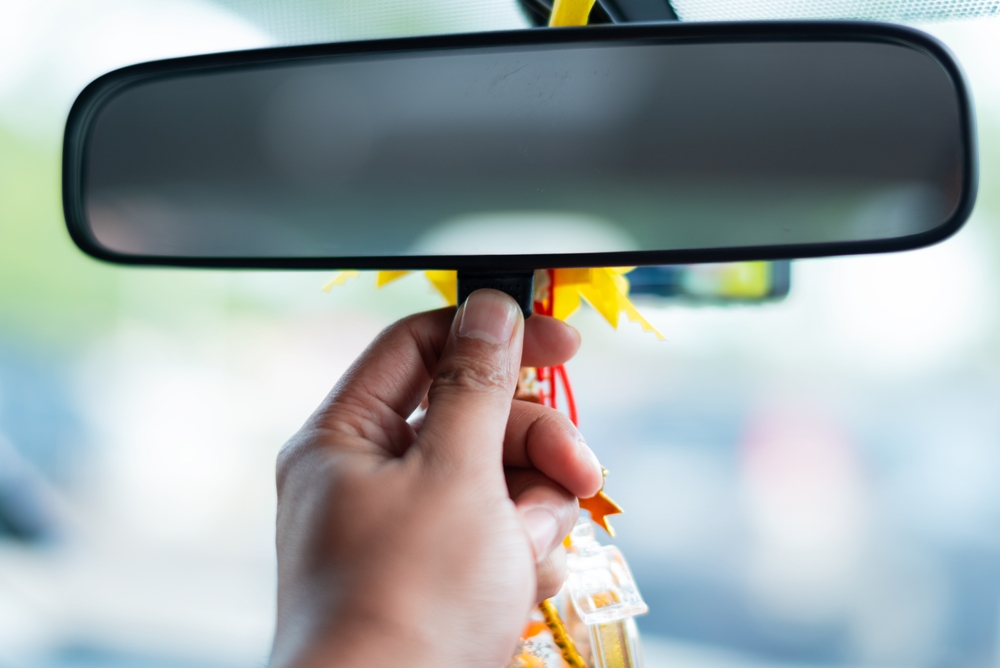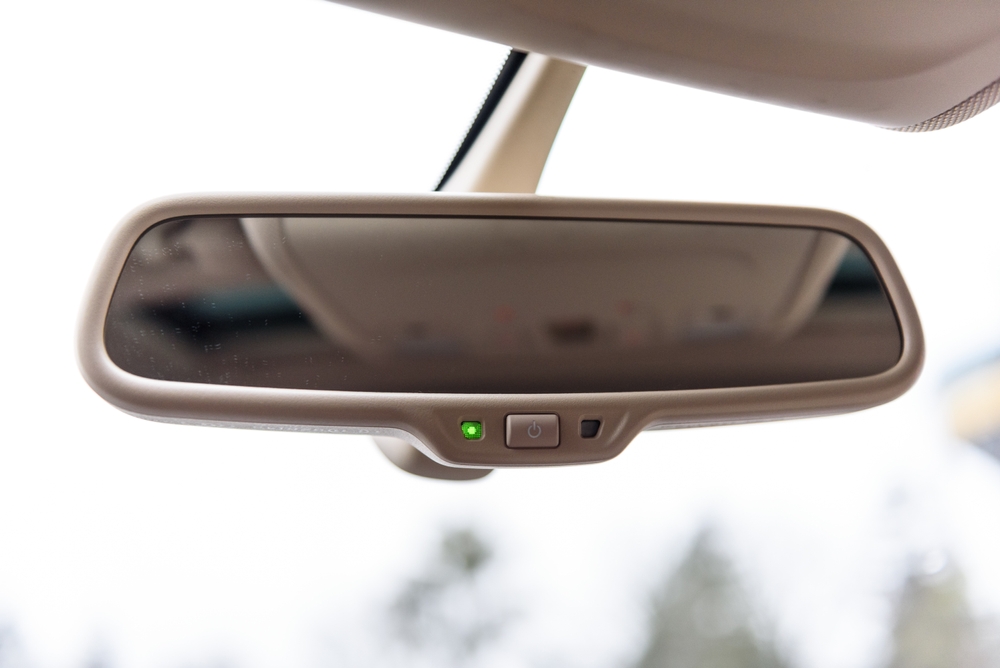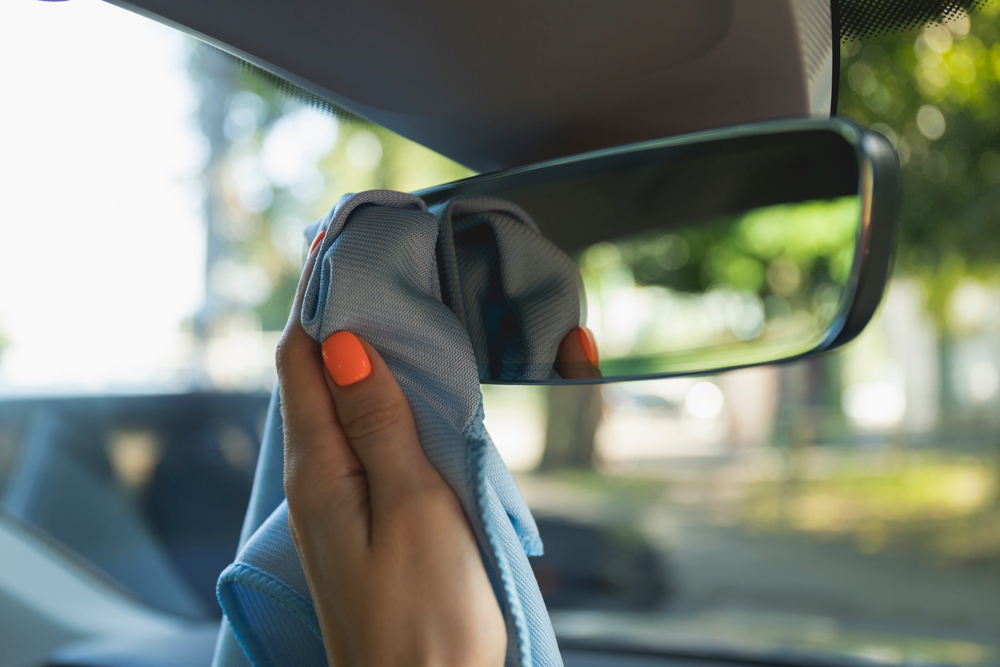The highway stretches dark ahead, and your headlights carve a tunnel through the night. A car pulls up behind with LED beams so bright they flood your rearview mirror with white light. The glare burns into your peripheral vision and makes the road ahead harder to see. Most drivers don’t know their rearview mirror has a built-in fix for headlight glare. Plenty of driving advice covers headlights and windshields, but the best tips for night visibility start right above your dashboard.

Image credit: Shutterstock
Your rearview mirror has a small tab that dims glare instantly. The tab sits at the bottom center of the mirror, usually about an inch wide and sticking out half an inch from the housing. Flip it forward when bright LED beams flood your view, and the blinding light drops to something manageable.
How The Dimming Works
The tab changes the angle of your mirror when you flip it. Some tabs push and pull while others flip up and down, but all make a subtle click when moved. That click tells you the mirror has tilted to its night position. The change looks subtle if no bright lights are hitting the mirror, so test it with headlights behind you to see the difference clearly.
The view behind you should stay visible, but it looks much darker. This happens because rearview mirrors use wedge-shaped glass with a reflective coating on the back surface. In the day position, light bounces off that back surface to give you a bright, clear reflection. Flip to night position, and the mirror tilts so the reflection comes from the weaker front surface instead.
The mirror’s geometry controls which reflection reaches your eyes. The front surface reflects only 4% of incoming light, while the back surface reflects around 80%. This difference creates the dimming effect without batteries or sensors, which explains why the design has barely changed since manual day/night mirrors first appeared in the 1930s and became standard equipment by the early 1970s.
Simple wedge shape and mechanical lever prove more reliable than many electronic alternatives because there are no batteries to die and no sensors to fail.
The dimmed view takes some getting used to because cars appear farther away than they actually are, but this tip makes sense for night driving when bright headlights can wipe out your vision for several seconds.
When to Switch Back at Night
Most drivers flip the tab once and forget it exists. Some leave it dimmed all day and ruin their visibility for no reason. Others never touch it and squint through glare. One simple driving tip when driving at night is to flip the tab based on what you see, not what time it is. Street lights and well-lit roads provide enough ambient light that dimming becomes unnecessary, so save it for dark country roads and highways where the contrast between darkness and bright headlights creates the worst glare.
Lane changes feel wrong at first because distances look off. The adjustment takes a few trips, but modern LED and HID headlights can be blinding for several seconds. The slight distortion beats losing vision when switching lanes.
The National Highway Traffic Safety Administration received over 4,000 public comments about headlight glare in 2001, more responses than any other safety concern that year. The problem hasn’t gone away. Headlights shifted from halogen to LED and HID technology, which made them brighter and more likely to cause glare. An online petition asking Congress to regulate these lights has collected over 50,000 signatures because more vehicles now use high-mounted lights that shine directly into rearview mirrors.
When Driving Dimmed Becomes Dangerous
The dimmed mirror helps on dark highways but fails in parking lots. Flip it back to day mode before backing up because the reduced brightness makes distances harder to judge. Shopping carts and concrete barriers can vanish entirely, so a routine backup turns risky.
Parallel parking demands the same precision. You need to see exactly where the curb sits and how close the car behind you is, but the dimmed reflection makes these judgments nearly impossible. Parking garages with their concrete pillars and tight spaces create the same problem, so flip the mirror back before you maneuver.
Don’t forget to switch back each morning. Driving with the dimmed mirror during daylight cuts your awareness of surrounding traffic, which makes lane changes riskier when you need clear views of cars behind you.
Electrochromic Mirrors Automate This
Flipping the tab forward at night and back each morning adds one more task to remember. Forget once while backing up, and you might hit a shopping cart that vanished in the dimmed reflection, so automatic mirrors handle the job for you.

American inventor Jacob Rabinow developed the first light-sensitive automatic mechanism for car rearview mirrors in the 1950s, earning a patent reported in a 1961 New York Times article. The device used a photocell to detect glare from headlights and automatically dimmed the mirror by tilting it with motors. But mechanical systems wear out, which pushed later inventors toward electronic solutions.
Gentex Corporation solved this problem in 1986 with electrochromic dimming, which became the best solution for driving after dark because the car mirror settings adjusted smoothly without mechanical parts. The technology uses a gel layer sandwiched between two pieces of glass that darkens when voltage flows through it. This means the mirror dims silently and adjusts to any brightness level instead of just two fixed positions.
Sensors control when the gel darkens. A forward sensor measures ambient light while a rear sensor watches for headlight glare behind you. When the rear sensor spots a bright light, it sends a voltage to the gel layer. The gel darkens in proportion to how bright those headlights are, so the dimming adjusts continuously as cars get closer or farther away. The mirror clears back to normal when the lights disappear.
These systems became standard on many mid-range vehicles by the 2010s as production costs fell. Side mirrors often use the same technology, dimming all three together. The rearview mirror tells the side mirrors when and how much to dim.
How to Know If Yours Is Automatic
Look for a tab or lever at the bottom of the mirror. If you don’t see one, the mirror uses automatic dimming because manual mirrors always have that mechanical switch.

Automatic mirrors have a small LED on the face that glows green or amber. The indicator shows the system has power, and it usually sits near the bottom edge of the glass. Some mirrors display AUTO when the feature runs.
Test the system by shining a flashlight at the mirror from behind your seat. The glass should darken gradually within a few seconds. If nothing happens, check the owner’s manual because some systems include an off switch or require activation through vehicle settings.
Most automatic systems let you adjust how aggressively they dim. Some vehicles bury this setting in the dashboard screen, while others put a button directly on the mirror. Adjusting the sensitivity ranks among the most useful night driving tips because factory settings don’t match every driver’s preference.
Older automatic mirrors sometimes fail when the gel degrades or sensors die. The mirror might stay dark permanently, ignore bright lights entirely, or dim inconsistently. Replacement costs depend on what else the mirror includes, so a basic auto-dimming mirror costs less than one with a compass display or garage door opener built in.
Buttons Instead of Tabs on Some Models
Some manufacturers add a motor to manual dimming controls. This design appears on certain European luxury brands like BMW and Mercedes, and some Lexus models. Press the button and the motor tilts the mirror between day and night positions. The button sits where a flip tab would normally be and makes a quiet whirring sound as the motor adjusts the angle. The change takes about a second. The button sometimes includes an LED that shows which mode is active.

The motorized button tilts the mirror just like a flip tab does, but a motor handles the work instead of finger pressure. This means the driver still decides when glare becomes a problem and presses the button to dim. Automatic mirrors eliminate this decision because sensors detect the glare and dim on their own.
How Automatic Mirrors Came to Exist
Drivers had dealt with headlight glare for decades by flipping a manual tab that changed the mirror angle. The tab worked, but required the driver to notice the glare and take action every time bright lights appeared behind them. Gentex Corporation automated this process in 1982 by connecting light sensors to a small motor that tilted the mirror when glare appeared. These electromechanical mirrors became optional equipment in luxury cars by 1983.
The motor system solved the glare problem, but the mechanical parts made it expensive and prone to failure. Engineers kept searching for more reliable ways to help the public drive safely at night and avoid accidents.
A father and son team of chemists brought Gentex the answer. They had developed an electrochromic gel that darkens when electricity flows through it and clears when the current stops. Gentex spent years refining a way to sandwich a thin gel layer between two pieces of glass. Sensors mounted on the mirror housing could now trigger an electrical charge that darkened the gel instantly, with no moving parts.
The first electrochromic mirror appeared in the 1988 Lincoln Continental. Eight GM models added the feature in 1989, and the technology spread through the industry during the early 1990s. Donnelly Corporation developed similar technology and tried to compete. Gentex sued them for patent violations in 1990, starting a legal battle that lasted through the decade. Both companies survived and kept making mirrors, but Gentex maintained the dominant position.
The Design Flaw That Ruined Interiors
Success bred competition, but competition bred problems. Magna Donnelly manufactured most automatic mirrors between the late 1990s and mid-2000s with seal materials that couldn’t withstand years of exposure to the gel and temperature cycling. The seals eventually broke down, and where they broke determined how fast the gel escaped.
Top breaches took weeks before bubbles or dark spots appeared as air seeped through. Bottom breaches started dripping the same day because gravity pulled the gel straight down through the opening. Sometimes the dimming function quits before any visible damage shows, leaving the mirror stuck dark or unable to dim at all. Once the gel escaped, it ate through the plastic trim and paint. Some owners found it pouring onto their center console without warning.
BMW moved all mirror production to Gentex in 2007 after warranty claims stacked up. Other manufacturers followed because Gentex had fixed the seal problem with better materials and manufacturing processes. Gentex now supplies about 85% of automatic mirrors worldwide, so most cars built after 2010 avoid this failure.
Cars from those problem years still exist. Any mirror showing gel bubbles or dimming issues needs removal before the liquid escapes and damages interior parts that cost far more than the replacement mirror itself.
The One Maintenance Tip Worth Remembering
Modern mirrors avoid the catastrophic seal failures that plagued older models, but dimming mirrors need regular cleaning to work properly. Fingerprints and skin oils scatter light in random directions, turning what should be a clear, dimmed view into a blurry mess.
Manual mirrors show this fastest because they reflect from the front glass surface in night mode. A single fingerprint creates a bright spot, and the oils attract dust between cleanings. Automatic mirrors face the same issue when touched during adjustments.
The trick is cleaning without causing damage. Ammonia-based glass cleaners attack the silvering until it separates from the glass, leaving permanent dark spots. Water or mild glass cleaner made for mirrors removes oils without attacking the coating.

Spray the cleaner on a microfiber cloth rather than directly on the mirror so liquid cannot seep behind the glass and corrode the electrical connections. Wipe in straight lines instead of circles to avoid streaks. Clean every few weeks, more often with frequent adjustments. Grab the housing or mounting arm when repositioning to avoid touching the glass in the first place.
A smeared mirror defeats the purpose of every night driving tip here, so keep the glass clean, and the dimming will work when bright lights hit during your night drive.



